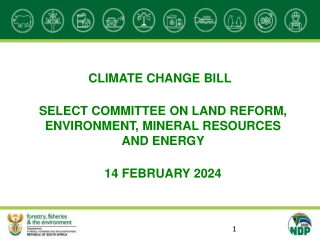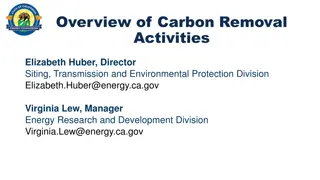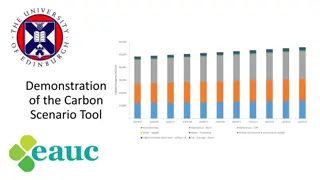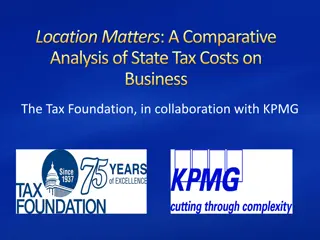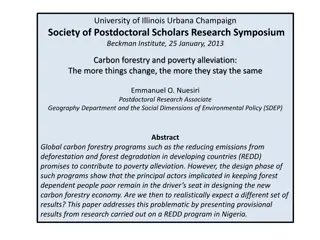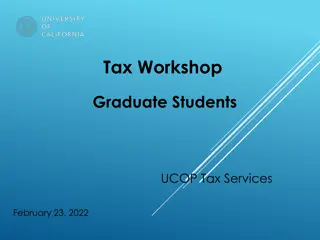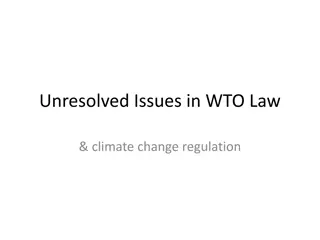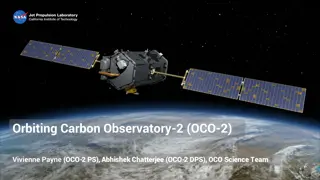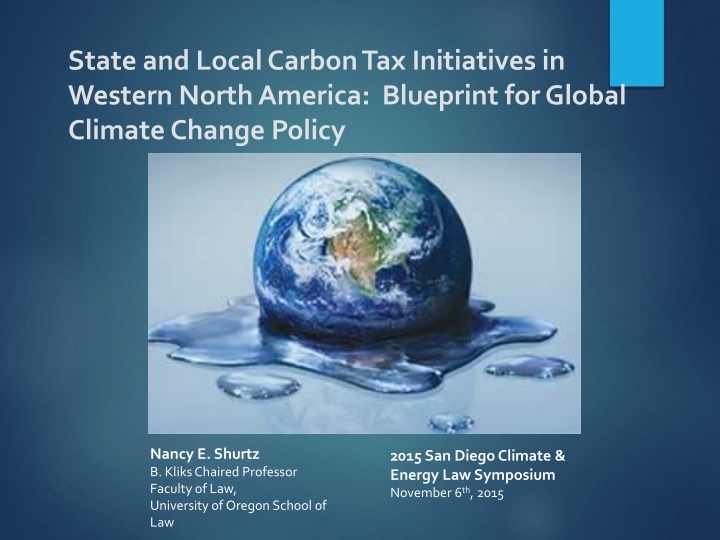
Carbon Tax Initiatives in Western North America: Blueprint for Climate Change Policy
Blueprint versus Scramble viewpoints on addressing environmental challenges, failures of international frameworks, insufficient federal initiatives, and successes and failures of carbon tax implementations in Western nations.
Download Presentation

Please find below an Image/Link to download the presentation.
The content on the website is provided AS IS for your information and personal use only. It may not be sold, licensed, or shared on other websites without obtaining consent from the author. If you encounter any issues during the download, it is possible that the publisher has removed the file from their server.
You are allowed to download the files provided on this website for personal or commercial use, subject to the condition that they are used lawfully. All files are the property of their respective owners.
The content on the website is provided AS IS for your information and personal use only. It may not be sold, licensed, or shared on other websites without obtaining consent from the author.
E N D
Presentation Transcript
State and Local Carbon Tax Initiatives in Western North America: Blueprint for Global Climate Change Policy Nancy E. Shurtz B. Kliks Chaired Professor Faculty of Law, University of Oregon School of Law 2015 San Diego Climate & Energy Law Symposium November 6th, 2015
Blueprint vs. Scramble Blueprint - Optimistic viewpoint - Local actions can address environmental challenges - Change comes from bottom up Scramble - Reactive - Events outpace actions - Change only when nature forces it - Policy makers pay little attention to problems
International Failure United Nations Framework Convention on Climate Change (UNFCCC), whose function for the last twenty years has been to ensure stabilization of greenhouse gases has failed. United Nations Convention to Combat Desertification, whose function for the last twenty years has been to stop land degradation and desertification has failed. Convention on Biological Diversity whose function for the last twenty years has been to reduce the rate of biodiversity loss has failed. Nineteen UN summit meetings on ratification of a treaty on global warming have failed.
Federal Initiatives: Not Comprehensive & Ineffective Good Policies Bad Policies Tax credit for purchase of alternative fuel vehicles Exclusions from income for employer- provided mass transit, van pool and bicycle benefits Tax deduction for donations of conservation easements Tax credits for energy efficient homes and commercial buildings Tax deduction for remediation of brownfields Oil and gas subsidies Timber subsidies Coal and nuclear subsidies Agricultural subsidies Housing subsidies Consumption subsidies Population subsidies No Carbon Tax No Cap-and-Trade
Foreign Successes and Failures Scandinavia Successes Other Countries Failures Norway: although with a similar tax rate as Denmark and Finland ($33/metric ton) the emissions increased by 32% between 1991 to 2014 Sweden: a very high tax rate ($168/metric ton) and all the money goes to reducing the government budget; emissions decreased 19% since 2003. Iceland: at a low tax rate of $10/metric ton, the money goes to the treasury with little restrictions; 17% increased emissions since its introduction Finland: similar to Sweden but with a lower tax rate ($48/metric ton); emissions decreased 23% from 2007 to 2011 but some reductions were due to the recession Costa Rica: similar to Iceland with a low tax rate between $1-14/metric ton depending on the industry with the funds going to climate mitigation programs; emissions increased 17% from 2000 to 2005 Denmark: similar rate to Finland ($31/metric ton) with a similar result, 33% decreased in emissions since 2006
Comparison with Cap-and-Trade Carbon Tax Cap-and-Trade Set tax per ton emitted Set level of emissions Determine quantity of allowances Monitor emissions Transparent Determine allocation of allowances Not concerned with set level of emissions Upstream/Downstre am? Easier to administer Free/Auction? Generates revenues Monitor emissions Model For Federal Government Monitor market
Comparing politics, efficacy, and equity Political Feasibility Equity Efficacy Cap-and-trade: The cap is not accurately set (either phase in the cap or create safety value mechanisms) Cap-and-trade: More acceptable by Politicians because it has been used in the past and is consistent with new EPA rules Cap-and-trade: No mechanisms to help low-income households Carbon tax: A $15/metric ton tax rate would increase electricity by $1.63 per kW-hr. However, the revenue from the tax can help alleviate the burden on low- income households Carbon tax: The rate is not impacting behavior (either increase rate overtime or allow tax credits and exemptions) Carbon tax: Possible willingness to support tax due to more transparency
Comparing Regional and State Initiatives in North America Successes: RGGI and CA/Quebec system Failures: Midwestern Accord and Western Climate Initiative The Regional Greenhouse Gas Initiative (RGGI) covers most of the northeast and mid-Atlantic states The Midwest Greenhouse Gas Reduction Accord (MGGRA) is a cap-and-trade system Since 2007, no cap-and-trade system has been designed yet Although not formally suspended, none of the states are pursuing its goals. The Western Climate Initiative (WCI) had 6 states and 2 provinces with 14 other jurisdictions joining Cap-and-trade was suppose to start in 2010 but fell apart when the recession occurred Governs only power plants (more limiting than CA/Quebec system) Majority of allowances were auctioned off in 2008 WCI became the CA/Quebec system after everyone else left the agreement The cap has had no adverse impacts on the economy but the cap is set too high
Californias Cap and Trade Program Pros Cons No drag on economic growth Cap set too low Some of permits given away free Has raised $1.6 billion Increased gas by 9-10 cents Money goes to reducing carbon emissions (particularly a high-speed rail system) Considered a fee so none of funds can go to reduce burden on low-income citizens Has been linked to Quebec
Boulder - Good Boulder s Climate Action Plan Excise Tax charges $0.0049 per kWh for residential, $0.0009 per kWh for commercial, and $0.0003 per kWh for industrial consumers. Boulder effectuates this tax by stating in the City Code, 3-12-1, that the City Council determines and declares that the consumption of electricity within the City is the exercise of a taxable privilege. Thus, a city can declare energy usage within its jurisdictional boundaries to be a privilege that can be subject to taxation and can reinvest that money in policies that provide tax incentives for consumers who invest in localized renewable power sources or green buildings that require less power to operate.
San Francisco - Better San Francisco s carbon tax requires businesses to pay 4.4 cents per ton of CO2 they emit. In 2008, the first year the tax was implemented, more than 2,500 businesses were required to pay the fee, which for most, was less than $1. Despite the low tax rate, about seven power plants and oil refineries had to pay more than $50,000 and a total of $1.1 million was generated in the first year. The money was used to pay for emissions-reduction programs around the city that by 2010, had contributed to a reduction in carbon emissions by 12% below the 1990 levels.
British Columbia - Best In 2008, British Columbia imposed a carbon tax of C$10 per ton of carbon dioxide equivalent emissions. This tax translates to roughly C$2.41 cents per liter of gasoline. The tax rate progressively increased each year until 2012, when it reached the final price of C$30 per ton. Because the tax is collected at the pump, the end result is a higher tax rate for those who travel the most. Thus, there is a direct correlation between pollution levels and the taxes levied against the most offensive polluters. British Columbia aims to reduce GHG emissions by 33% by 2020 and by 80% by 2050, compared to 2007 levels.
Western U.S. Carbon Tax Proposals Oregon Tax rate will start at $10/metric ton and increase until $60/metric ton at 2025 Revenue neutral tax meaning the revenue will go to reducing other taxes like corporate tax, income tax Favorable economic study Washington Tax rate will start at $15/metric ton and increase to $25 by 2018 Revenue will go to lowering the state sales tax Favorable economic study
Importance of Local Initiatives Many climate change problems stem from local transportation and land-use problems that lead to higher rates of energy consumption. It is within the local jurisdiction s authority to plan and solve these problems. Changing the behavior of people and businesses is often more effectively accomplished when done at the local level. Cumulative effects from enough local environmental initiatives can have a national (and international impact). Since over 51% of people now live in urban areas, a number that is expected to increase, changing behaviors in just a few city sectors, such as transportation and land use policies, can have a considerable impact on climate change. In the absence of effective federal and international initiatives, local governments pursuing unique initiatives can serve as a blueprint for the federal government by offering innovative ideas that can translate into national and international initiatives.
Assessment & Summary Disappointing number of world-wide carbon initiatives. Cap-and-trade dominates over carbon taxes. Areas most effected by climate change have the least amount of initiatives. Countries taking action are the richer countries who have benefited in the past. Many localities propose promising tax policies that are never implemented. Use of revenue from the carbon initiatives vary, but often shift taxes off poor. Carbon initiatives are often ineffective, due to economic and political concerns. Local tax policies work best with mandates, tax incentives and other policies. Local carbon policies can only work with community support and political leadership. What is needed is global leadership and international hard law.
Conclusion (1) Regional cap-and-trade system should be linked throughout North America (like current CA and Quebec system), (2) State and city carbon taxes should be passed throughout North America (like BC, Boulder and San Francisco), (3) Additional mandates and incentives are needed, (4) Challenges can be overcome, and, (5) North America has ethical duty to act.


